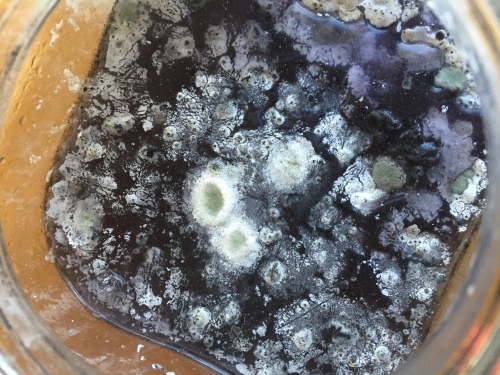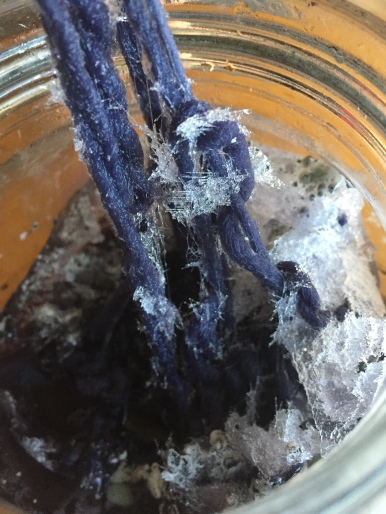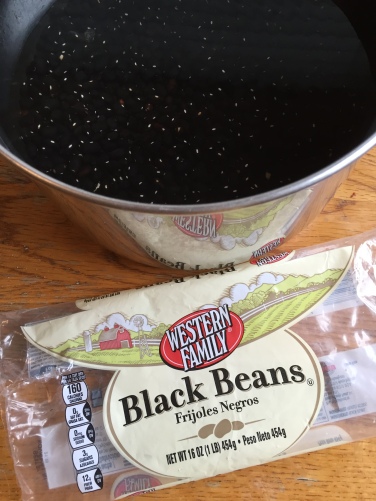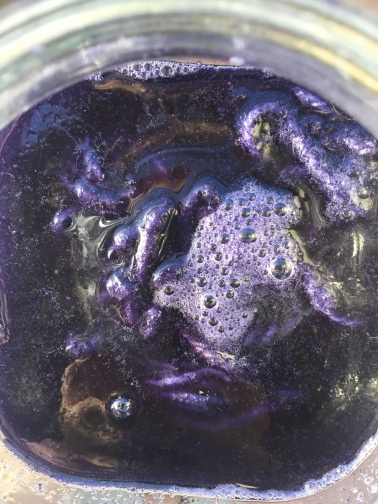
Beans. I’m not a fan.
However, black bean dye has the potential to make my favorite color – teal blue.
The first time I soaked black beans for 24 hours, I was wowed by the purple. Purple!
I finally felt inspired to experiment with dyes for the first time in a long time. This color lit a fire under my creative ass. Three minutes of online research taught me this:
- Black bean dye is a cold dye (or a solar dye)
- Heat kills the color. Don’t use heat
- Use alum as a mordant
Ok. Got it. I threw this project together in about 10 minutes:
- One 3 oz skein of 100% wool (not mordanted)
- Tossed it into the bean water (sans beans)
- A pinch of alum
- Swished it around
- Put it on my front porch
- Went to work all week
- Checked on it the following weekend


Laziest. Dye. Ever.
I’ll call this color Frozen Almost Purplish. Not bad for 10% effort. But I knew I could do better.
The following weekend I tried it again:
- Soaked a bag of beans for 24 hours.
- Poured the water into my jar.
- Most important new step — tested the pH of the water.
If I want blue, the dye must be alkaline. My dye water started at pH7. I added 2 tsps of washing soda, which bumped it up to pH10. The color went from purple to green. Lovely, but that’s too alkaline to make blue. I poured in the last bit of bean water to add a little acidity, and added my wool (2-3oz skein).
I also didn’t leave it outside. I placed the dye jar on top of my fridge in my warm kitchen. Not sure this changes the dye, but it was worth a shot.
A warning — not only does this dye stink after a day or two, it contains pressure. When I opened it a few days later, the top popped off (pinching my finger), and the yarn looked eager to burst out like a trapped beast. I called it done.
GORGEOUS. I’m not a fan of eating beans, but I’ll dye with them any day.
******************************
Update:
As mentioned in the comments, this dye did not keep it’s color for long. This blue faded to a gray within months. While I dye for the process of creating color, and I firmly believe that should be the goal, it’s also important to think about how the yarn will look in the future. Especially before it’s used in a time consuming, beloved project! Something to keep in mind. Happy dyeing.






I think I like the purple color even more. 🙂
You would. 😉
Brillant results! I never tryed beans for dyeing, but your pictures and explanations motivates me so much. Hoping to find simular beans here.
Yay! I’m glad this motivates you to give it a try. Let me know how it goes – good luck!
This looks beautiful!
I am really interested in getting natural blues and purples, but a lot of them have serious fading issues. Do you have any insight or experience with the colorfastness of beans?
This is my first experience dyeing with beans, so I don’t have experience with their colorfastness *yet*. Doing a premordant on the yarn (with alum when using beans) should be a huge help with colorfastness. I was also warned that this dye would fade, but I didn’t let it stop me. I was told the same about my blackberry dyed yarn, and it’s still a lovely purple several years later. And honestly — I dye because I enjoy the process. Most natural dyes slowly fade over time; some fade faster than others. Blues and purples are notorious for fading the fastest.If it fades over time, that’s fine. I’ll just dye it again. 🙂
I totally agree! I have some blackberry dyed yarns in knitted pieces from years ago and I think they fade less than people say (they get grey for sure, but it’s still a pretty grey-purple). I also premordant – but I read about how you added sugar and think that’s a great idea!
These are gorgeous results! I’ve tried black beans in the past but my results were a bit bland so I’ve never attempted it again but now I want to! May I ask, is the wool you use superwash? I’ve noticed people tend to get better results with black beans when it is. Thanks!
Claire
http://flossiknitwear.tumblr.com/
Claire – great question! And I honestly don’t remember. When I use wool my priority is always the content (100% animal fiber) and how it feels.